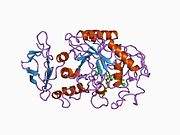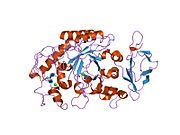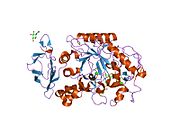-
1b2y: STRUCTURE OF HUMAN PANCREATIC ALPHA-AMYLASE IN COMPLEX WITH THE CARBOHYDRATE INHIBITOR ACARBOSE
-
1bsi: HUMAN PANCREATIC ALPHA-AMYLASE FROM PICHIA PASTORIS, GLYCOSYLATED PROTEIN
-
1c8q: STRUCTURE SOLUTION AND REFINEMENT OF THE RECOMBINANT HUMAN SALIVARY AMYLASE
-
1cpu: SUBSITE MAPPING OF THE ACTIVE SITE OF HUMAN PANCREATIC ALPHA-AMYLASE USING SUBSTRATES, THE PHARMACOLOGICAL INHIBITOR ACARBOSE, AND AN ACTIVE SITE VARIANT
-
1hny: The structure of human pancreatic alpha-amylase at 1.8 angstroms resolution and comparisons with related enzymes
-
1jxj: Role of mobile loop in the mechanism of human salivary amylase
-
1jxk: Role of the mobile loop in the mechanism of human salivary amylase
-
1kb3: Three Dimensional Structure Analysis of the R195A Variant of Human Pancreatic Alpha Amylase
-
1kbb: Mechanistic Analyses of Catalysis in Human Pancreatic alpha-Amylase: Detailed Kinetic and Structural Studies of Mutants of Three Conserved Carboxylic Acids
-
1kbk: Mechanistic Analyses of Catalysis in Human Pancreatic Alpha-Amylase: Detailed Kinetic and Structural Studies of Mutants of Three Conserved Carboxylic Acids
-
1kgu: THREE DIMENSIONAL STRUCTURE ANALYSIS OF THE R337A VARIANT OF HUMAN PANCREATIC ALPHA-AMYLASE
-
1kgw: THREE DIMENSIONAL STRUCTURE ANALYSIS OF THE R337Q VARIANT OF HUMAN PANCREATIC ALPHA-MYLASE
-
1kgx: Three Dimensional Structure Analysis of the R195Q Variant of Human Pancreatic Alpha Amylase
-
1mfu: Probing the role of a mobile loop in human salivary amylase: Structural studies on the loop-deleted mutant
-
1mfv: Probing the role of a mobile loop in human slaivary amylase: Structural studies on the loop-deleted enzyme
-
1nm9: Crystal structure of recombinant human salivary amylase mutant W58A
-
1q4n: Structural studies of Phe256Trp of human salivary alpha-amylase: implications for the role of a conserved water molecule and its associated chain in enzyme activity
-
1smd: HUMAN SALIVARY AMYLASE
-
1u2y: In situ extension as an approach for identifying novel alpha-amylase inhibitors, structure containing D-gluconhydroximo-1,5-lactam
-
1u30: In situ extension as an approach for identifying novel alpha-amylase inhibitors, structure containing maltosyl-alpha (1,4)-D-gluconhydroximo-1,5-lactam
-
1u33: In situ extension as an approach for identifying novel alpha-amylase inhibitors
-
1xcw: Acarbose Rearrangement Mechanism Implied by the Kinetic and Structural Analysis of Human Pancreatic alpha-Amylase in Complex with Analogues and Their Elongated Counterparts
-
1xcx: Acarbose Rearrangement Mechanism Implied by the Kinetic and Structural Analysis of Human Pancreatic alpha-Amylase in Complex with Analogues and Their Elongated Counterparts
-
1xd0: Acarbose Rearrangement Mechanism Implied by the Kinetic and Structural Analysis of Human Pancreatic alpha-Amylase in Complex with Analogues and Their Elongated Counterparts
-
1xd1: Acarbose Rearrangement Mechanism Implied by the Kinetic and Structural Analysis of Human Pancreatic alpha-Amylase in Complex with Analogues and Their Elongated Counterparts
-
1xgz: Structure of the N298S variant of human pancreatic alpha-amylase
-
1xh0: Structure of the N298S variant of human pancreatic alpha-amylase complexed with acarbose
-
1xh1: Structure of the N298S variant of human pancreatic alpha-amylase complexed with chloride
-
1xh2: Structure of the N298S variant of human pancreatic alpha-amylase complexed with chloride and acarbose
-
1xv8: Crystal Structure of Human Salivary Alpha-Amylase Dimer
-
1z32: Structure-function relationships in human salivary alpha-amylase: Role of aromatic residues
-
2cpu: SUBSITE MAPPING OF THE ACTIVE SITE OF HUMAN PANCREATIC ALPHA-AMYLASE USING SUBSTRATES, THE PHARMACOLOGICAL INHIBITOR ACARBOSE, AND AN ACTIVE SITE VARIANT
-
3cpu: SUBSITE MAPPING OF THE ACTIVE SITE OF HUMAN PANCREATIC ALPHA-AMYLASE USING SUBSTRATES, THE PHARMACOLOGICAL INHIBITOR ACARBOSE, AND AN ACTIVE SITE VARIANT




































Well, that’s interesting to know that Psilotum nudum are known as whisk ferns. Psilotum nudum is the commoner species of the two. While the P. flaccidum is a rare species and is found in the tropical islands. Both the species are usually epiphytic in habit and grow upon tree ferns. These species may also be terrestrial and grow in humus or in the crevices of the rocks.
View the detailed Guide of Psilotum nudum: Detailed Study Of Psilotum Nudum (Whisk Fern), Classification, Anatomy, Reproduction